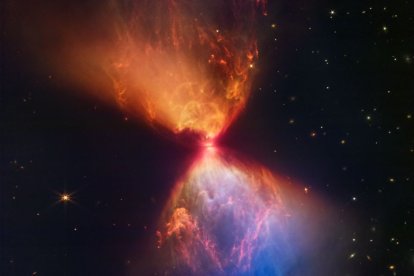James Webb Telescope captures the birth of a new star
It is a star in the shape of an hourglass. It is about 100,000 years old and is in a period of formation.

(NASA)
NASA's James Webb Space Telescope captures the birth of a new star hidden in the center of the dark cloud L1527, which takes the shape of a blue and orange hourglass. These clouds are only visible through infrared light, making it an ideal target for the so-called near-infrared camera (NIRCam), an instrument that is part of the Webb telescope. This is the same instrument that captured new images of the so-called pillars of creation.
The color of these clouds surrounding the protostar is a result of the thickness of the dust between Webb and the clouds. The blue areas indicate where the dust is thinner and in the orange areas show where the dust layer is thicker.
The dark cloud is 'only' 100,000 years old so it is considered relatively young. Due to the brightness of its colors and its early age, it is estimated to be in the earliest stage of star formation, so this protostar still has a long way to go before it becomes a fully developed star.
L1527 does not yet generate its own energy through a nuclear fusion of hydrogen (an essential feature of stars). Its shape, which is still unstable, is that of a small mass of hot, swollen gas containing 20-40% of the solar mass. As the protostar gains mass, its core compresses toward stable nuclear fusion.
The cloud is made up of gas and dust which come together at the center, where the protostar is located. As the material falls and spirals around the center it creates a disk known as a creation disk that feeds the protostar. That is, as the protostar gains mass and compresses, the temperature of its core increases, allowing stable nuclear fusion that will lead to the creation of a star.
RECOMMENDATION





















